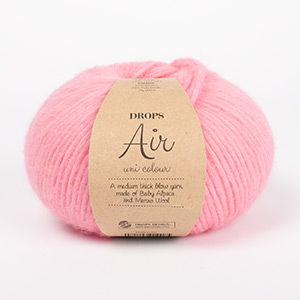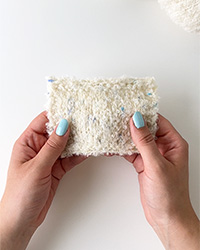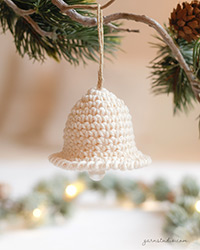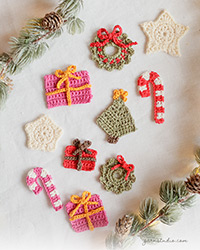Cómo leer los diagramas de punto
Un diagrama de punto consiste de cuadrados. 1 cuadrado = 1 punto – la definición del símbolo proporciona información acerca de cómo tejer el punto. El diagrama muestra todos los puntos vistos por el lado derecho (a menos que se especifique de otra manera).
Un diagrama se ve así:

- A.1 es el nombre del diagrama, y se refiere al diagrama entero.
- A.2 es solo la parte del diagrama que está dentro de los cuadrados separados por líneas más oscuras.
- Este número se refiere al número de puntos en la 1ᵃ hilera del diagrama.
- Esta es la definición de los símbolos: explica cómo tejer cada punto, o en qué color (en patrones multicolores).
Un diagrama se lee completamente en sentido contrario a cómo leemos normalmente: de derecha a izquierda, de abajo para arriba. Es decir, se comienza con el símbolo en la esquina inferior derecha, y se va tejiendo hacia la izquierda y en dirección hacia arriba (ver lo señalado en ROJO en el diagrama abajo). Si tienes que comenzar en un cuadrado diferente/con un punto diferente, esto será especificado – por ejemplo: las diferentes tallas pueden comenzar en diferentes lugares en el mismo diagrama (ver el rectángulo azul abajo).

Si tienes que tejer varias repeticiones de un diagrama (es decir: tejer el mismo diagrama varias veces a lo ancho) vas a tejer hasta el fin de la hilera del diagrama, y comenzarás nuevamente con el primer punto para la repetición siguiente.
De ida y vuelta:
Cuando se teje de ida y vuelta, se teje una hilera por el lado derecho de la labor y una hilera por el lado revés de la labor. Como los diagramas muestran todos los puntos vistos por el lado derecho, tendrás que tejer en el sentido contrario cuando se teje por el lado revés (ver las flechas AZULES en el diagrama abajo): lees la hilera de izquierda a derecha, los puntos derechos se tejen de revés, y los puntos reveses se tejen de derecho, etc (esto frecuentemente va a estar especificado en la definición de los símbolos: “derecho por el lado derecho, revés por el lado revés”).

En redondo:
Cuando se teje en redondo, todas las vueltas son tejidas por el lado derecho, y el diagrama es leído completamente de derecha a izquierda. Cuando se comienza una nueva vuelta, simplemente comenzar tejiendo el primer símbolo de la hilera siguiente del diagrama.

Varios diagramas diferentes tejidos consecutivamente en la hilera/vuelta:
Si estás tejiendo varios diagramas diferentes, uno después del otro en la misma hilera/vuelta, tejer de la manera siguiente: Tejer la 1ᵃ hilera del diagrama 1, continuar con la 1ª hilera del diagrama 2, después la 1ª hilera del diagrama 3, etc. RECUERDA: si estás tejiendo de ida y vuelta, el diagrama tendrá que ser tejido en el orden contrario por el lado revés – es decir: comenzar con el diagrama 3, después el diagrama 2 y, por último, el diagrama 1. También son tejidos en sentido contrario como se hace habitualmente.

En el patrón, esto puede estar escrito de la manera siguiente: “tejer A.1, A.2, A.3 un total de 1-1-2-3-4 veces”. Esto quiere decir que primero tejes A.1, después A.2 y, finalmente, repites A.3 un total de 1-1-2-3-4 veces (dependiendo de tu talla). Es SOLO el diagrama A.3 que es repetido, A.1 y A.2 se tejen 1 vez cada uno.
Cuando el número de puntos no corresponde a las repeticiones completas del diagrama:
A veces, el número de puntos no es divisible con las repeticiones completas del diagrama a tejer a lo ancho de la labor. Por ejemplo: A.1 cubre 12 puntos y debe ser repetido sobre 40 puntos. En este caso, vas a tejer 3 repeticiones completas de A.1 (= 36 puntos) y después vas a tejer los primeros 4 puntos del diagrama sobre los puntos restantes (ver la línea ROJA abajo). Usualmente este es el caso donde el diagrama es un patrón repetitivo y, por eso, independientemente de tejer repeticiones completas o no, el patrón será consistente.














I am knitting Bronz summer sweater. I’m a little unsure with pattern A1. In row 3 it is shown that you are supposed to put one stitch on a cable needle like you have two stiches. If I understand correctly I’m supposed to increase in row three so I only have one knitted stich + the one I increased. I sure hope you get what I’m trying to say 😂
01.02.2023 - 16:27